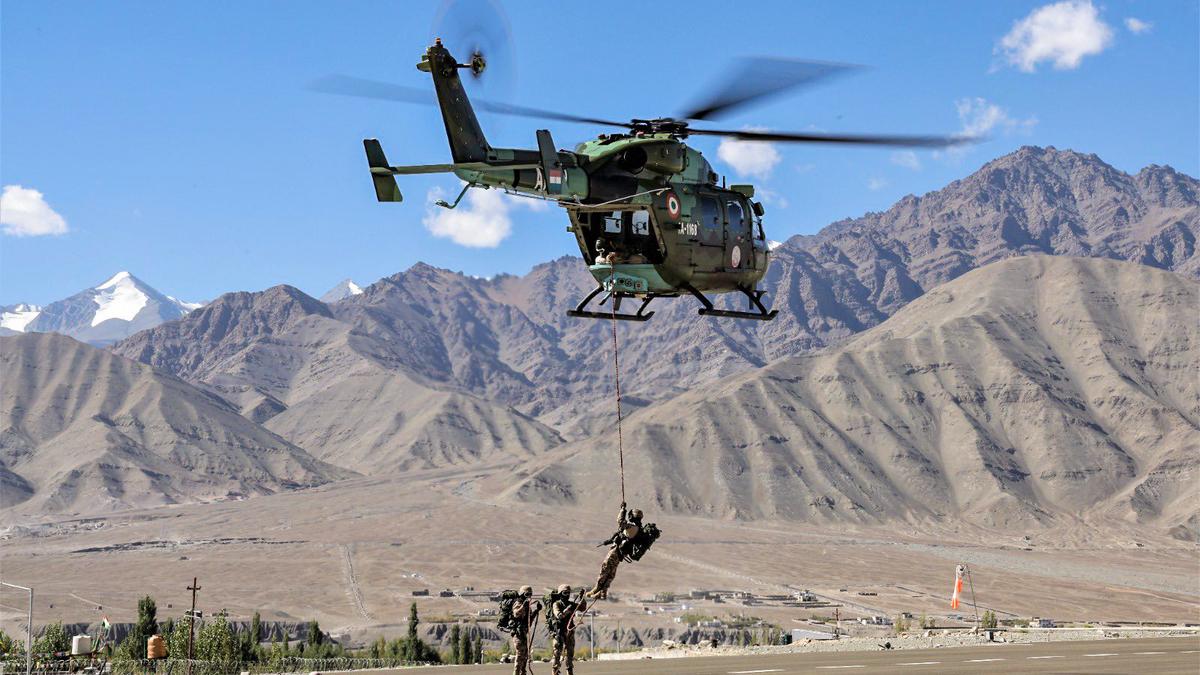Indian Army Aviation’s ALH Dhruv & Cheetal helicopters showcase rescue and slithering operations in the Ladakh sector. File
| Photo Credit: ANI
While the Army’s efforts to replace the vintage Cheetah and Chetak utility helicopters continues, officials at the Aviation Brigade in Leh explained how they along with the Cheetal as well as the Advanced Light Helicopters (ALH) continue to remain a lifeline for supporting troops in the high altitude areas, including Siachen glacier.
The indigenous Light Utility Helicopter (LUH), manufactured by Hindustan Aeronautics Limited (HAL), meant to replace the Cheetah and Chetak is taking shape but behind schedule, officials said. “The Army needs 225 LUH and a deal for 110 LUH is currently in the cost negotiation stage,” a defence source stated. Their induction in enough numbers is going to take sometime, another source said.

Lifeline in high altitude
Officers and technicians at the Army Aviation Brigade in Leh, which operates ALH, Cheetals and Unmanned Aerial vehicles, explained how these helicopters are a lifeline in supplying logistics, casualty evacuation among other roles in the forward most areas of Ladakh. The Cheetal is an upgraded version of the Cheetah, featuring the same engine as the ALH MK1 and Mk2, explained Maj. Ayush Devliyal from the Corps of Electronics and Mechanical Engineers (EME). The Cheetal holds the record for landing at an altitude of 23,000 feet.
Since the May 2020 standoff with China in Eastern Ladakh, which is still underway, the Army has carried a major reorientation of troops towards the Line of Actual Control (LAC) and several thousand troops were inducted into the area which meant extending the logistics and supply chains, both by road and through the air to support them. Army Aviation too has upped its tempo of operations to cater to the requirements of troops support, surveillance and being ready for operations if needed.

Giving a sense of their tasks, Col. Randeep Pathania, Commanding Officer of the ALH squadron, noted how varied the terrain is. We have icy heights of glacier, we have heights but dry deserts of Eastern Ladakh, we have hilly terrain or high mountains of Western Ladakh which is Drass and Kargil, he noted. “Each sector we have fragmented here is unique and definitely a very challenging and difficult terrain, he said speaking to a few visiting journalists last weekend. We need to understand the machine and all aspects related to the machine so that we can undertake flying here. The tasks here are very essential.”
The entire aim is to have synergy between, not only with other aviation assets, but also with ground formations, observed Lt. Col. Amit Ansal also from EME. “The Aviation squadron regularly practices with various formations so that one plan can come out and the role is understood by one and all during operations.”
Highlighting an important aspect, Brig. Gurdeep Singh commanding the Aviation Brigade said the civil administration also requisitions them for number of tasks. The recently concluded Lok Sabha elections, there are some areas which even in summers are cut off, so induction of polling officials along with Electronic Voting Machines (EVM), we did that, he said. “Number of posts in Zanskar area, where we flew almost 80 hours utilising a number of helicopters for inducting polling officials, security officials and EVMs and de-inducting them.”
Army Aviation has three Brigades at Leh, Missamari and Jodhpur operating around 190 Cheetah, Chetak and Cheetal helicopters, 145 ALH, 75 of which are the Rudra weaponised variants and 25 ALH Mk-III on order in addition to the Light Combat Helicopter under induction. Of the 190 Cheetah, Chetaks, and Cheetals in service, around 134 helicopters or over 70% of them are over 30 years old, as reported by The Hindu earlier.
Published – September 25, 2024 10:44 pm IST

